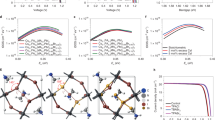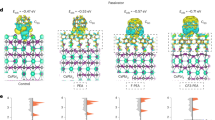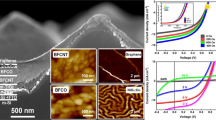Abstract
Multiferroic films are increasingly being studied for applications in solar energy conversion because of their efficient ferroelectric polarization-driven carrier separation and above-bandgap generated photovoltages, which in principle can lead to energy conversion efficiencies beyond the maximum value (∼34%) reported in traditional silicon-based bipolar heterojunction solar cells. However, the efficiency reported so far is still too low (<2%) to be considered for commercialization. Here, we demonstrate a new approach to effectively tune the bandgap of double perovskite multiferroic oxides by engineering the cationic ordering for the case of Bi2FeCrO6. Using this approach, we report a power conversion efficiency of 8.1% under AM 1.5 G irradiation (100 mW cm−2) for Bi2FeCrO6 thin-film solar cells in a multilayer configuration.
This is a preview of subscription content, access via your institution
Access options
Subscribe to this journal
Receive 12 print issues and online access
$209.00 per year
only $17.42 per issue
Buy this article
- Purchase on Springer Link
- Instant access to full article PDF
Prices may be subject to local taxes which are calculated during checkout





Similar content being viewed by others
References
Chynoweth, A. G. Surface space-charge layers in barium titanate. Phys. Rev. 102, 705 (1956).
Chen, F. S. Optically induced change of refractive indices in LiNbO3 and LiTaO3 . J. Appl. Phys. 40, 3389 (1969).
Yang, S. Y. et al. Above-bandgap voltages from ferroelectric photovoltaic devices. Nature Nanotech. 5, 143–147 (2010).
Nechache, R. et al. Photovoltaic properties of Bi2FeCrO6 epitaxial thin films. Appl. Phys. Lett. 98, 202902 (2011).
Yuan, Y. et al. Efficiency enhancement in organic solar cells with ferroelectric polymers. Nature Mater. 10, 296–302 (2011).
Alexe, M. & Hesse, D. Tip-enhanced photovoltaic effects in bismuth ferrite. Nature Commun. 2, 256 (2011).
Nechache, R., Ruediger, A. & Rosei, F. Combined pn junction and bulk photovoltaic device. US patent 13/162,186 (2011).
Glass, A. M., von der Linde, D. & Negran, T. J. High-voltage bulk photovoltaic effect and the photorefractive process in LiNbO3 . Appl. Phys. Lett. 25, 233–235 (1974).
Josch, W., Munser, R., Ruppel, W. & Wurfel, P. The photovoltaic effect and the charge transport in LiNbO3 . Ferroelectrics 21, 623–625 (1978).
Koch, W. T. H., Munser, R., Ruppel, W. & Wurfel, P. Bulk photovoltaic effect in BaTiO3 . Solid State Commun. 17, 847 (1975).
Robertson, J., Warren, W. L. & Tuttle, B. Band states and shallow hole traps in Pb(Zr,Ti)O3 ferroelectrics. J. Appl. Phys. 77, 3975 (1995).
Yang, S., Zhang, Y. & Mo, D. A. Comparison of the optical properties of amorphous and polycrystalline PZT thin films deposited by the sol–gel method. Mater. Sci. Eng. B 127, 117–122 (2006).
Chanussot, G. Physical models for the photoferroelectric phenomena. Ferroelectrics 20, 37–50 (1978).
Qin, M., Yao, K. & Liang, Y. C. High efficient photovoltaics in nanoscaled ferroelectric thin films. Appl. Phys. Lett. 93, 122904 (2008).
Bhatnagar, A., Chaudhuri, A. R., Kim, Y. H., Hesse, D. & Alexe, M. Role of domain walls in the abnormal photovoltaic effect in BiFeO3 . Nature Commun. 4, 2835 (2013).
Zheng, F. et al. Above 1% efficiency of a ferroelectric solar cell based on the Pb(Zr,Ti)O3 film. J. Mater. Chem. A 2, 1363 (2014).
Zhang, G. et al. New high Tc multiferroics KBiFe2O5 with narrow band gap and promising photovoltaic effect. Sci. Rep. 3, 1265 (2013).
Ji, W., Yao, K. & Liang, Y. C. Bulk photovoltaic effect at visible wavelength in epitaxial ferroelectric BiFeO3 thin films. Adv. Mater. 22, 1763–1766 (2010).
Grinberg, I. et al. Perovskite oxides for visible-light-absorbing ferroelectric and photovoltaic materials. Nature 503, 509–512 (2013).
Choi, W. S. et al. Wide bandgap tunability in complex transition metal oxides by site-specific substitution. Nature Commun. 3, 689 (2012).
Nechache, R. et al. Epitaxial thin films of the multiferroic double perovskite Bi2FeCrO6 grown on (100)-oriented SrTiO3 substrates: growth, characterization, and optimization. J. Appl. Phys. 105, 061621 (2009).
Xu, X. S. et al. Tunable band gap in Bi(Fe1− xMnx)O3 films. Appl. Phys. Lett. 96, 192901 (2010).
Kamba, S. et al. Infrared and magnetic characterization of multiferroic Bi2FeCrO6 thin films over a broad temperature range. Phys. Rev. B 77, 104111 (2008).
Nechache, R. et al. Epitaxial patterning of Bi2FeCrO6 double perovskite nanostructures: multiferroic at room temperature. Adv. Mater. 23, 1724–1729 (2011).
Shimada, T., Nakamura, J., Motohashi, T., Yamauchi, H. & Karppinen, M. Kinetics and thermodynamics of the degree of order of the B cations in double-perovskite Sr2FeMoO6 . Chem. Mater. 15, 4494–4497 (2003).
Nechache, R., Harnagea, C. & Pignolet, A. Multiferroic properties–structure relationships in epitaxial Bi2FeCrO6 thin films: recent developments. J. Phys. Condens. Matter. 24, 096001 (2012).
Andreasson, J. et al. Electron-lattice interactions in the perovskite LaFe0.5Cr0.5O3 characterized by optical spectroscopy and LDA+U calculations. Phys. Rev. B 80, 075103 (2009).
Tai, C. W. & Baba-Kishi, K. Z. Influence of annealing on B-site order and dielectric properties of (0.4)Pb(In1/2Nb1/2)O3:(0.6)Pb(Mg1/3Nb2/3)O3 relaxor ceramics . J. Appl. Phys. 100, 116103 (2006).
Baba-Kishi, K. Z. & Baber, D. J. Transmission electron microscope studies of phase transitions in single crystals and ceramics of ferroelectric Pb(Sc1/2Ta1/2)O3 . J. Appl. Crystallogr. 23, 43–54 (1990).
Perrin, C. et al. Influence of B-site chemical ordering on the dielectric response of the Pb(Sc1/2Nb1/2)O3 relaxor. J. Phys. Condens. Matter 13, 10231–10245 (2001).
Sargent, E. H. Colloidal quantum dot solar cells. Nature Photon. 6, 133–135 (2012).
Maksymovych, P. et al. Polarization control of electron tunneling into ferroelectric surfaces. Science 324, 1421 (2009).
Guo, Y., Guo, B., Dong, W., Li, H. & Liu, H. Evidence for oxygen vacancy or ferroelectric polarization induced switchable diode and photovoltaic effects in BiFeO3 based thin films. Nanotechnology 24, 275201 (2013).
Malinkiewicz, O. et al. Perovskite solar cells employing organic charge-transport layers. Nature Photon. 8, 128–132 (2014).
Liu, D. & Kelly, T. L. Perovskite solar cells with a planar heterojunction structure prepared using room-temperature solution processing techniques. Nature Photon. 8, 133–138 (2014).
Park, N. G. Organometal perovskite light absorbers toward a 20% efficiency low-cost solid-state mesoscopic solar cell. J. Phys. Chem. Lett. 4, 2423–2429 (2013).
Acknowledgements
The authors acknowledge financial support from the Canada Foundation for Innovation, which funded the facilities for materials deposition and characterization as well as device fabrication and testing. F.R. is grateful to the Canada Research Chairs Program for partial salary support. F.R. is supported by Discovery (NSERC) and FQRNT team grants. This work was partly funded by an international collaboration grant (MDEIE) with the European Network WIROX. F.R. acknowledges the Alexander von Humboldt Foundation for a F.W. Bessel Award. F.R. is grateful to Elsevier for a grant from Applied Surface Science. R.N. is grateful to NSERC for a personal postdoctoral fellowship for partial salary support. S.L. thanks FRQNT and CSC for salary support. L.C. acknowledges partial salary support through a personal fellowship from FRQS.
Author information
Authors and Affiliations
Contributions
R.N. designed the materials and device optimization strategy. R.N., S.L. and J.C. fabricated and characterized the structural, composition, FE and photovoltaic properties of the films. R.N. and L.C. performed UPS analysis. R.N., W.H. and S.L. carried out the NSTO deposition and electrical and optical measurements for the devices. R.N. and C.H. designed the piezoresponse force microscopy experiments and supervised the analysis of the results and their interpretation. R.N., C.H. and F.R. co-wrote the paper. F.R. supervised the work.
Corresponding authors
Ethics declarations
Competing interests
R.N. and F.R. declare that a US patent related to the PV properties of BFCO films was filed in 2011 under reference 13/162,186.
Supplementary information
Supplementary information
Supplementary information (PDF 3456 kb)
Supplementary movie
Supplementary movie (MOV 204172 kb)
Rights and permissions
About this article
Cite this article
Nechache, R., Harnagea, C., Li, S. et al. Bandgap tuning of multiferroic oxide solar cells. Nature Photon 9, 61–67 (2015). https://doi.org/10.1038/nphoton.2014.255
Received:
Accepted:
Published:
Issue Date:
DOI: https://doi.org/10.1038/nphoton.2014.255
This article is cited by
-
Suppressing non-radiative recombination in metal halide perovskite solar cells by synergistic effect of ferroelasticity
Nature Communications (2023)
-
Preparation of β-CuGaO2 thin films by ion-exchange of β-NaGaO2 film fabricated by a solgel method
Emergent Materials (2023)
-
Green and cost-effective morter grinding synthesis of bismuth-doped halide perovskites as efficient absorber materials
Journal of Materials Science: Materials in Electronics (2023)
-
Preparation of multiferroic lead iron niobate thin film with low crystallization temperature via sol–gel method using monoethanolamine
Journal of the Korean Ceramic Society (2023)
-
The magnetoelectric coupling effect of multiferroic fluids and their potential applications
Journal of Materials Science: Materials in Electronics (2023)



